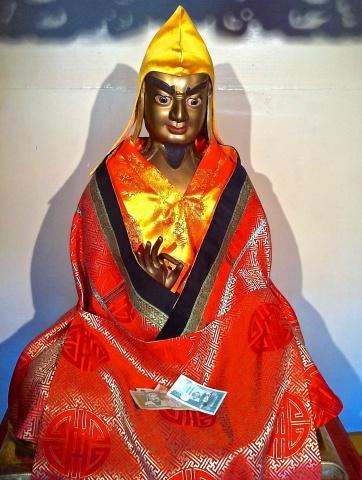Part of the Meditative Praxis Interview series
“To know yourself, know your enemy.” This is not a military axiom, but a historical reality that Professor Eli Franco emphasized in his recent interview with us. “Buddhist and Brahmanical philosophy in their most productive period, roughly from the 4th to the 12th century, developed above all because of their mutual opposition,” he noted. “One cannot understand the development of Buddhist philosophy without the critique voiced by Nyaya and Mimamsa philosophers, and vice versa.” The way in which Buddhist philosophy benefited from its rivals may seem surprising and troublesome to those of us drawn to narratives of simplistic opposition in medieval India, culminating in the Brahminical and Islamic victory over Buddhism in South Asia.
The disappearance of Buddhism from the centre of Indian civilization may never be fully understood. But Professor Franco’s research at the Institut für Indologie und Zentralasienwissenschaften (University of Leipzig) has often centred on Indology’s relatively overlooked traditions. His 1980 doctorate, Lokayata, la philosophie dite matérialiste de l’Inde classique, focused on the materialist school that historically positioned itself against orthodox Brahmanism, as well as Buddhism and Jainism. Yet the debates among the various traditions were not inspired by a mere sectarian rivalry, but by the genuine interest to understand the ultimate nature of reality. One immediate example could be overlapping of philosophical and meditative concepts. “Many of the so-called ‘points of debate’ among Buddhists, Brahmanical and Jaina philosophers are also important topics in Buddhist meditation; for instance, the topic of anatman (the denial of a permanent soul) or the topic of momentariness (kshanikatva, i.e., the theory that all things last only one moment).
Discovering the connections between Buddhist and opposing ideas is difficult task, but may yet reap important findings about Buddhism’s position within the wider world of South Asian philosophy. This complex association between Buddhism and its Indic competitors finds a historical representative in the figure of Jitari (ca. 940 – 980), a philosopher and Tantra master who was acutely attuned to the religious and philosophical debates of his time (and also served as the focus for Franco’s paper in August’s conference). Franco gave special attention to topic of reverse causation not because it is more important than others, but because it is almost completely unknown. Jitari’s work on reverse causation is essentially captured in the question, “Must the cause always precede the effect, or can it sometimes be the other way round, namely, can the cause be in the future and the effect in the past or the present?” This doctrine was first developed by the great Buddhist philosopher Prajnakaragupta in order to prove life after death.
“To illustrate this doctrine, Prajnakaragupta used the phenomenon of omens, which were widely believed to exist in ancient India. A good or bad omen, Prajnakaragupta says, is not the cause good fortune or misfortune, but the result of a future event that somehow already looms over us. Hence, we can infer that there is life after death because of the impact of future life on the present one. Take the common present-day example of a black cat crossing our path. This is supposed to bring about bad luck, but how could a cat possibly do that? It is rather the other way round. The imminent bad luck causes the cat to cross our path.





“As is the case in practically all Buddhist traditions, Jitari understood meditation as a third step in a sequence: after ‘hearing’ (i.e., studying) the Buddha’s words, one ‘thinks’ about them (that is, one examines them rationally, which includes arguing and debating about them), and finally their understanding gained through thinking is deepened in meditation. Thus, meditation cannot be divorced from its content.”
For Franco, this has implications for modernist paradigms of meditative applications. “It is for this reason that I am rather skeptical about the usefulness of the current fashionable trend that associates meditation with neurosciences. Neurosciences cannot tell us anything about the content of meditation, and it is the content which matters, at least from a Buddhist point of view. The purpose of mediation is to gain a liberating insight into the ultimate nature of reality. Neurosciences cannot help us here because questions about truth or goodness (or beauty, to mention the third great ideal of our civilization) are simply beyond their scope.”
The life of Jitari himself seems to resonate with Franco’s theme of mixture and interaction, but in a much more obvious way: “In his History of Buddhism, Taranatha reports that Jitari’s mother was a Shudra queen and his father a Tantric Brahmin called Garbhapada. His father initiated (gave abhisheka to) the king Sanatana and received the queen, in addition to gold, horses, elephants, for services that were apparently much appreciated. Jitari was thus a mixed-caste child, and his comrades at the Brahmin school gave him a hard time because of that. He then stopped going to school and meditated at home on Manjughosha, and this gave him free access to all branches of learning. Taranatha further says that he was so gifted that he learnt practically without studying. It was enough for him to read the most difficult texts once or twice in order to master them.”
As for the monastic universities in Jitari’s lifetime? “The two great monastic universities were Nalanda and Vikramashila. Jitari is said to have taught at Vikramashila and was presumably an excellent teacher, both in Tantra and in Pramana [the study of epistemology and logic in Buddhist dialectic and debate]. Among his disciples was the famous Atisha. However, according to another account, Jitari was the custodian of the Northern Gate at Nalanda. Yet this may have been another Jitari. To reconcile the conflicting traditions, the Tibetan scholars assume that there were two Jitaris, whom they call the Senior and the Junior Jitari. Taranatha [1575 – 1634] gives a short account about the Senior Jitari, but as is often the case, one cannot separate facts from legends.”
Whether Jitari himself, or the events associated with him, are a myth is probably not as important as what he represents. Like medieval Buddhism itself, he embodies a Buddhist who has benefited from rivalry, debate, and argumentation with adherents and missionaries of opposing faiths. Perhaps there is a lesson in interfaith dialogue here, something which I’ve read and written about often: By knowing your rivals or opponents, you come to know yourself, but when you realize how much your tradition has benefited from said rivalry – how much of yourself is actually the Other.
Professor Eli Franco specializes in Indian Philosophy and Buddhist Studies at the University of Leipzig.












